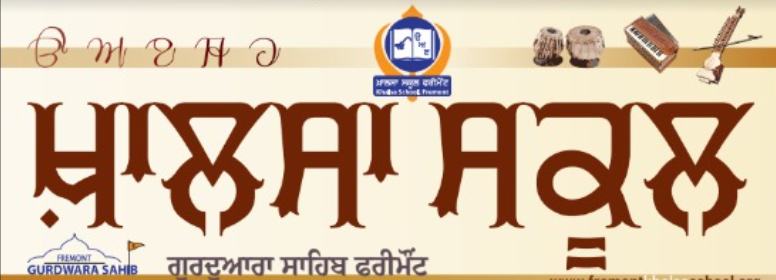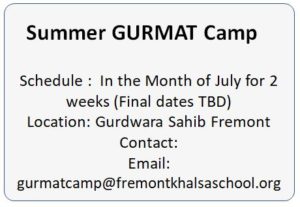School Etiquette and Discipline:
The following rules and guidelines are imposed to uplift the education standards and improve the student’s ability to be successful. Avoid disruption and distraction, and to improve the quality of the classroom experience.
These rules must be observed and followed and the expectations fulfilled. Non-compliance will result into student termination
- Student must go to the main Darbaar Hall and bow to Sri Guru Granth Sahib before starting the classes.
- Please arrive on time to class and stay for the entire class period. Late arrivals and early departures are disruptive.
- Quietly take a seat in the classroom. Similarly, in the rare event that you must leave class early (e.g. for a medical appointment), sit close to the rear door and leave as unobtrusively as possible.
- During class session, ask permission before leaving to use the restroom. Try to use the restroom before coming to class.
- When class begins, please stop your conversations.
- Wait until class is completely over before putting your materials away in your backpack, standing up, or talking to friends.
- Talking on cell phones, or text messaging during class is not allowed. Smart Phones and other Electronic gadgets if used in the class will be confiscated.
- Try not to dominate a discussion with your questions or comments – give others a fair opportunity to participate.
- Raised voices, derogatory language, name-calling, and intimidating behavior will NOT be tolerated. Do not disturb others by engaging in disruptive behavior. Disruption interferes with the learning environment and impairs the ability of others to focus, participate, and engage.
- During the class, no parent is allowed to walk into the class for any reason
- If parent need some clarification from teacher, please meet the teacher at the end of the class
- If parent have some dispute issue regarding teacher or school policy, please meet any member of the Office Staff.
- Students and teachers are required to wear an outfit that is fit for Gurdwara environment.
Gatka is the Sikh martial art which has been thoroughly battle-tested and has existed Since Guru Hargobind Sahib Ji’s times. It is considered to be a spiritual as well as a physical exercise. Both these aspects of the person are developed to a high level during the learning phase in this ancient art. Although it uses the sword as its primary weapon, many other weapons have been added to Gatka over the time. Today, this art exists exclusively amongst the Sikhs who have passed down the flamboyant techniques through generations, since Guru Hargobind Sahib Ji wore the two swords of Miri and Piri.
Gatka is a complete martial system which uses spiritual, mental and physical skills in equal portions to help one fully competent in defending themselves and others.
In addition to giving the student defensive skills, it also helps the individual with other aspects of their life: makes the mind alert and responsive, maintains the body in a near perfect condition and makes soul fearless, compassionate and tranquil.
The techniques involved are extremely effective for defence and attack as well as visually spectacular. The Sikhs mastered Gatka and perfected its use in battle. Many battles were won by the Sikhs, despite almost always numbering far fewer than the opposite forces. The techniques within Gatka were combined with the spiritual practices of the Sikhs to create a perfect fighting system. Opposing forces have documented how awesome the Sikhs were at battle!
The art of Gatka involves a series of integral combat training systems that include several systems of duels armed – unarmed and the use of weapons of defense. It aims at the coordination of mind & body through the meditation of spiritual verses of Gurbani, a holistic system by which the character and moral attitude of a student is shaped.
While Khalsa School focuses on intellectual knowledge about Sikhism, We encourage our students to be active in Sports as well. The Khalsa School Coach for Soccer team, Gurbeer Singh Bhullar has singlehandedly taken the responsibility to take out our kids into the Soccer Field every Saturday at 10:00 AM. He runs his practice sessions all year long! Over the last over two years, he has brought out the best in his team and we are glad to announce Fremont Khalsa School team in the near future.
Please click here (Appendix A) to download the Soccer enrollment form.
Please click here (Appendix B)to download Liability Waiver Form. Please fill-up this form and attach it to the enrollment form.
Public Speaking and Debate Classes:
To enable the kids with Corporate and Outreach Objectives, Khalsa School also provides Public Speaking classes via six weeks structured course taught on weekdays. This brings the best out of the kids and make them confident in daily lives and be a good corporate citizens.
The Public Speaking classes were put on hold last year due to lack of space during building construction. We will reinstate the classes as soon as new Khalsa School building is complete.
Please click here (Appendix C) to download the Public Speaking Enrollment form.
Grading System
Fremont Khalsa School follow the grading structure as follows:
1. Attendance: 20% of the overall grade is based on attendance. All teachers are required to take attendance at the beginning of the class. The school Office Staff maintains the attendance records. Minimum of 60% attendance is required to qualify for promotion. i.e.; All students are required to attend minimum of 20 classes in a year.
The Parent – Teacher conference is held if any student who is absent for more than 3 classes in a row. This may result into disciplinary action.
2. Homework Assignments: 20% of the overall grade is based on Homework assignments. The Khalsa School Office staff encourage the teachers to follow Homework assignments for grading but it is up to teachers’ discretion to manage this policy
3. Test Grades: 60% of the overall grade is based on test scores. Khalsa School holds Midterm tests in December followed by the Final tests in May. It is up to teachers if they want to give out more tests and quizzes to test the knowledge in frequent basis.
It is also up to the teachers to distribute some percentage of the total score on class projects and presentations. Projects and presentations are generally used for spiritual and personal development and solidify confidence in children.
The Parents are encouraged to work closely with the teachers to understand the grade policy for your child(ren)’s class(es).
Test Grade Structure:
Fremont Khalsa School follows California State standards for Grading. The Grading Structure is as follows:
“A+”: 96% to 100%
“A” : 90% to 95%
“B+” : 86% to 90%
“B” : 80% to 85%
“C” : 70% to 79%
“D” : 60% to 69%
“F” : 0% to 59%
The Khalsa School teachers and Office Staff will contact the parents of “D” Grades students to discuss areas that need development. Promotion to the next grade level may be considered conditional and subject to establishing and fulfilling a remediation plan agreeable between the student, parents, teacher, and the school office staff.
“F” defines unsatisfactory work. The Circumstances contributing to this grade stem from various development factors in student’s educational development environment. Student , Teacher, Teacher, Office Staff, and Parent conference is mandatory to discuss factors leading to this situation. Students are encouraged to repeat the same class and improve the test scores for promotion to the next level. Parent – Student – Teacher conference is required at mid-term and final exam stages to assess progress.
|
Book: Gurmat Sangeet Keertan, Level: Beginner
|
|
| 1. | 10 Alankaar and Vocal Training with Sargams |
| 2. | Learn Basic Notes, Saptak, Shudh, Komal and Teebar Sur |
| 3. | Learn 1st Shabad from book: Rakha Ek Hamara Suami |
| 4. | Read, sing and memorize notes and Shabad |
| 5. | Learn 2nd Shabad: Mohe Na Bisaroh Mai Jan Tera |
| 6. | Learn 3rd Shabad: Samrath Guru Sir Hath Dhario |
| 7. | Learn 4th Shabad: Jo Mangeh Thakur Apne Te |
| 8. | Learn 5th Shabad: Sewak Kee Ardas Piaare |
| 9. | Read, sing and memorize notes and Shabads |
| 10. | Review 1st Five Shabads |
|
Book: Gurmat Sangeet Keertan, Level: 1
|
|
| 1. | Alankaar Practice and Vocal Training with Sargams |
| 2. | Learn Basic Notes, Saptak, Shudh, Komal and Teebar Sur |
| 3. | Learn Notation and Definitions: Aroh, Avroh, Asthaaee, Antraa, Vaadee, Samvaadee, Jaatee, Alaap, Taan and Taal |
| 4. | Learn 1st Shabad:
Charan Kamal Prabh Ke Nit Dhiaavoh, |
| 5. | Learn 2nd Shabad:
Rakhaa Ek Hamaara Suami |
| 6. | Learn 3rd Shabad:
Bhaj Mann Mere Aeko Naam |
| 7. | Read, sing and memorize notes and Shabads |
| 8. | Learn 4th Shabad:
Prabh Sio Laag Raheo Mera Cheet |
| 9. | Learn 5th Shabad:
Aisee Preet Govind Sio Laagee |
| 10. | Read, sing and memorize notes and Shabad |
| 11. | Review 1st five Shabads with Taana and Alaap |
|
Book: Gurmat Sangeet Keertan, Level: 2
|
|
| 1. | Alankaar Practice and Vocal Training with Sargams |
| 2. | Learn Basic Notes, Saptak, Shudh, Komal and Teebar Sur |
| 3. | Learn Definitions:
Aroh, Avroh, Asthaaee, Antraa, |
| 4. | Learn Notation, Thaat and Important signs used in the Book |
| 5. | Learn 1st Shabad:
Bisar Gayee Sab Taat Paraayee |
| 6. | Learn 2nd Shabad:
Sajanaa Sant Aao Mere |
| 7. | Learn 3rd Shabad:
Gobind Gobind Gobind Maye |
| 8. | Learn 4th Shabad:
Sadaa Sadaa Japeeai Har Naam |
| 9. | Read, sing and memorize notes and Shabads |
| 10. | Review 1st four Shabads with Taana and Alaap |
| 11. | Learn 5th Shabad:
Ghanahar Baras Sagal Jag Chhaaya |
| 12. | Learn 6th Shabad:
Hey Gobind Hey Gopaal |
| 13. | Learn 7th Shabad:
Bandnaa Har Bandnaa |
| 14. | Learn 8th Shabad:
Hao Bal Bal Jao Ramayeeaa Kaarne |
| 15. | Read, sing and memorize notes and Shabads |
| 16. | Review all Shabads with Taana and Alaap |
The Khalsa School Sewadaars thrives to work cohesively and establish an educative path for the young Khalsa. The objectives of the Khalsa School are in-line with raising our next generation Sikh Children with wealth and strength of Gurmat values.
The Education programs are focused on two broader categories:
1. Teaching Gurmukhi as a Language so that our Children can read and understand Gurbani from Guru Granth Sahib Jee.
2. Teaching Sikh History and Gurmat to enrich the minds and souls of our young children. Gurmat Classes foster Sikhi way of life through practicing Rehat Maryada in our daily lives.
Class Curriculum:
PreSchool and PreKindergarten
Pre-School: 3 to 4 Years, Pre-Kindergarten: 4 to 5 Years
| Gurmukhi Classes |
|
| Gurmat Classes |
|
Kindergarten
5 to 6 Years
| Gurmukhi Classes |
|
| Gurmat Classes |
|
Level 1
6 to 7 Years
| Gurmukhi Classes |
|
| Gurmat Classes |
|
Level 2
7 to 8 Years
| Gurmukhi Classes |
|
| Gurmat Classes |
|
Level 3
7 to 9 Years
| Gurmukhi Classes |
|
| Gurmat Classes |
|
Level 4
9 to 11 Years
| Gurmukhi Classes |
|
| Gurmat Classes |
|
Level 5
10 to 12 Years
| Gurmukhi Classes |
|
| Gurmat Classes |
|
Level 6
11 to 13 Years
| Gurmukhi Classes |
|
| Gurmat Classes |
|
Level 7
12 to 15 Years
| Gurmukhi Classes |
|
| Gurmat Classes |
|
Leadership Class
15 to 19 Years
| Leadership class has created a great environment for the youth of the Gurdwara to come together and work on various projects to help Sikhi shine through dedicated individuals, reflecting on the Sikh community. Students represent the older segment of Khalsa School and organize regular events throughout the year, such as the Vaisakhi Keertan Darbaar, Sikh Children’s Day, and Gurpurab Celebrations. This class allows students to take initiative and work amongst one another to encourage more youth to attend Gurdwara programs and connect with their Sikh heritage. Within the class, students hold discussions on various topics to do with areas in Sikhi that scholars have done heavy research upon and take away valuable life lessons |
Pre-School
This program is a parent and child program for children 3 and 4 years old. A strict cutoff date for admission into this program is enforced. A child must be 3 years old as of September 1 of the year seeking admission. It is a 1-hour class with hands-on activities and provides an introduction to language and Gurmat in an age appropriate manner.
Elementary Levels: Kindergarten and Levels 1 through 4
Kindergarten has a combined Gurmat and Gurmukhi program, while Level 1 through 4 have an hour each of instruction in Gurmat and Gurmukhi.
Senior Levels: Level 5 through 7
Level 7 is the graduating class at Fremont Khalsa School
Leadership Class
Once a student graduates Fremont Khalsa School, he/she is eligible to be part of the Leadership Class. This class is designed for teens. This class plays a key role in organizing all the special events that Fremont Khalsa School organizes throughout the year.
Bridge Class
For students who are in grade 4 and up are first time learners, or their language skills are not commensurate with the standard Level 4 path of the Gurmukhi Language – there is a “bridge” program. This program provides customized accelerated learning to students, and mainstreams them as they become ready to be part of the regular learning path.









